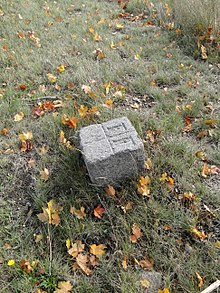Friedrich Paschen (geodesist)
Friedrich (Heinrich Christian) Paschen (born November 20, 1804 in Schwerin ; † August 24, 1873 there ) was a geodesist and astronomer .
origin
Friedrich Paschen was the first of eight children of the government registrar and later court counselor Carl Friedrich Paschen and his wife, Sophie Christiane, née. Hommel born. In 1832 he married Sophia Maria Wilhelmine Krey. The marriage had six children: Johann Friedrich Heinrich Paschen (1833–1900), the father of the physicist Friedrich Paschen (1865–1947), Carl (Theodor Heinrich) Paschen (1835–1911, German Vice Admiral), Julius Wilhelm Heinrich Paschen ( * 1836) and Ottilie Sophie Marie (* 1838), Johanne Friederike Betty Paschen (* 1842), Adele Henriette Dorothee Caroline (* 1848, called Ina, married to Wilhelm Foerster , director of the Berlin observatory). The lawyer and member of the Mecklenburg Assembly of Representatives August Philipp Conrad Paschen (1814-1882) was his younger brother.
education
Paschen probably attended the cathedral school ( Fridericianum ). He then studied law in Göttingen (1824–1825), Berlin (1825–1826), Rostock (1826) and again Göttingen (1826–1828). In Rostock he joined the Corps Vandalia Rostock and in Göttingen the Corps Vandalia Göttingen. The second study visit to Göttingen brought him together with Carl Friedrich Gauß , during which his already existing interest in astronomy was strengthened and surveying was added.
job
After passing the bar exam in 1828, Paschen worked as a government registrar assistant in the government office in Schwerin from 1831 . In 1836 he was appointed Real Government Registrar . During this time he followed with interest the geodetic and astronomical activities of Johann Jacob Baeyer , who carried out a coastal survey in East Prussia in 1837. He also maintained contact with Heinrich Christian Schumacher , the director of the Altona observatory and editor of the “Astronomical News”.
Baeyer was working on a the Baltic cross- triangulation ( "Danish port 1839-1841") and sent his results, which also affected the Mecklenburg coast, the Grand Ducal Ministry in Schwerin. Here Paschen was commissioned to develop a statement on Baeyer's draft, which should contain the statement as to whether a state survey was necessary for Mecklenburg . He examined the design not only with regard to the technical premises (triangulation, topography), but also with regard to the financial effects and came to a positive result, making convincing arguments for the urgent need for a land survey for practical purposes and also for science.
Through extensive measurements and investigations, Paschen found out that the existing survey bases and map series were incorrect. In 1848 Paschen began a long-term measurement of the water level in the Baltic Sea, which resulted in the establishment of the zero point of the Grand Ducal Mecklenburg Elevation Network at the Wismar gauge . Until 1852 he wrote analyzes, memoranda and calculations for the triangular network. On August 2, 1852, the grand ducal decree was issued that “a complete trigonometric survey of the country was to be carried out in connection with the main triangular networks already in existence in the neighboring states.” From 1853 onwards, the survey of the country began. Paschen, who had meanwhile become Ministerial Secretary , and a Captain Koehler were entrusted with the scientific and technical management. In 1860 the work on the fixed point network of the 1st to 3rd order was completed and Paschen was then appointed court councilor.
Individual evidence
- ^ In the Rostock matriculation portal there is no evidence of Friedrich Paschen's matriculation, only that of his brother (Heinrich Friedrich) Wilhelm Paschen (* July 5, 1806 in Schwerin; † January 29, 1879 in Bützow) on May 2, 1827 ( entry )
- ↑ Kösener Corpslisten 1960, 119 , 49
Web links
- Literature about Friedrich Paschen in the state bibliography MV
- Publications by F. Paschen in the Astrophysics Data System
- Friedrich HC Paschen - the Mecklenburg geodesist and astronomer on his 200th birthday. Ed .: DVW - German Association for Surveying e. V., Mecklenburg-Western Pomerania Regional Association. Schwerin 2004 ( full text PDF, 3.7 MB)
| personal data | |
|---|---|
| SURNAME | Paschen, Friedrich |
| ALTERNATIVE NAMES | Paschen, Friedrich Heinrich Christian (full name) |
| BRIEF DESCRIPTION | German astronomer and geodesist |
| DATE OF BIRTH | November 20, 1804 |
| PLACE OF BIRTH | Schwerin |
| DATE OF DEATH | August 24, 1873 |
| Place of death | Schwerin |
